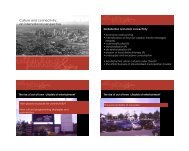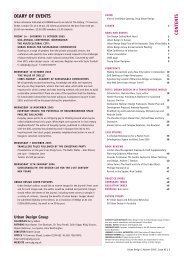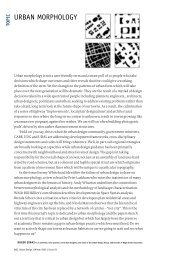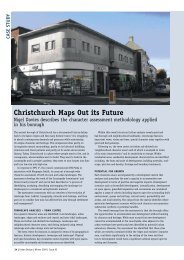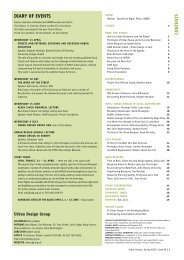topic - urban-design-group.org.uk
topic - urban-design-group.org.uk
topic - urban-design-group.org.uk
Create successful ePaper yourself
Turn your PDF publications into a flip-book with our unique Google optimized e-Paper software.
TOPIC<br />
TRANSFORMING SOUTH YORKSHIRE<br />
Peter O’Brien highlights the issues arising in this pathfinder area<br />
To many, the image of the nine housing<br />
market renewal pathfinders is one<br />
characterised by streets of abandoned<br />
terraces and an air of dereliction and<br />
decay. During the past 18 months,<br />
Transform South Yorkshire (TSY),<br />
the South Yorkshire pathfinder, has<br />
welcomed a multitude of government<br />
officials, ministers and representatives<br />
from regeneration <strong>org</strong>anisations. The first<br />
part of the tour has occasionally been<br />
accompanied by puzzled looks, as the<br />
streets of abandoned, boarded up houses,<br />
characteristic of many of the other<br />
pathfinders, fail to appear.<br />
South Yorkshire does not conform<br />
to the stereotypical view of the<br />
HMR pathfinders. The area has not<br />
experienced the type of market collapse<br />
evident in other parts of the north and<br />
Midlands; it is characterised by a large<br />
number of pockets of low demand,<br />
especially for social housing, and many<br />
neighbourhoods are at risk of major<br />
decline if action is not taken urgently.<br />
So, as the largest pathfinder,<br />
embracing almost 140,000 homes, a<br />
population of over 306,000 and covering<br />
parts of the Barnsley, Doncaster,<br />
Rotherham and Sheffield local authority<br />
areas, what does low demand and market<br />
failure mean in South Yorkshire, and how<br />
are the issues being addressed?<br />
The headline statistics show 86 per cent of the housing stock<br />
‘at risk’, 43 per cent socially rented, and a mere nine per cent<br />
detached houses. Values averaged less than £46,000 in 2002,<br />
compared with over £80,000 in the remainder of South Yorkshire<br />
– itself hardly a high value area. And the disparity is increasing:<br />
price rises between 1996 and 2002 lagged 13 per cent between<br />
those in the sub-region. Yet paradoxically, overall less than five<br />
per cent of dwellings are vacant, contrasting starkly with the 10<br />
to 15 per cent void rates experienced elsewhere in the northern<br />
cities. The housing market in South Yorkshire is failing, but<br />
crisis point has yet to be reached. This context has provided<br />
the pathfinder with the opportunity to demonstrate that<br />
preventative intervention can be successful, and that a thriving<br />
housing market is an essential ingredient to successful economic<br />
regeneration.<br />
To understand the dynamics of the housing market, an<br />
appreciation of the changing economic and demographic<br />
fortunes of South Yorkshire is essential. In the mid 1980s, the<br />
Dearne Valley had 12 collieries, employing over 11,000 people;<br />
it now has none. A quarter of all jobs in Sheffield were lost. By<br />
1998, GDP in South Yorkshire was only 74 per cent of the UK<br />
average, with levels of economic inactivity reaching 42 per cent<br />
in the pathfinder. In the 10 years after 1991, the population of the<br />
pathfinder fell by 4.4 per cent (and up to 35 per cent in parts of<br />
Doncaster) - with the highest rate of loss amongst the 25-44 age<br />
<strong>group</strong>.<br />
Yet since those dismal days, a growing range of imaginative<br />
regeneration initiatives, supported by government and by the<br />
European Union has seen over 2,000 net new jobs being created<br />
each year in Sheffield, with unemployment now less than one<br />
per cent above the national rate, and GDP increasing faster<br />
22 | Urban Design | Autumn 2004 | Issue 92



